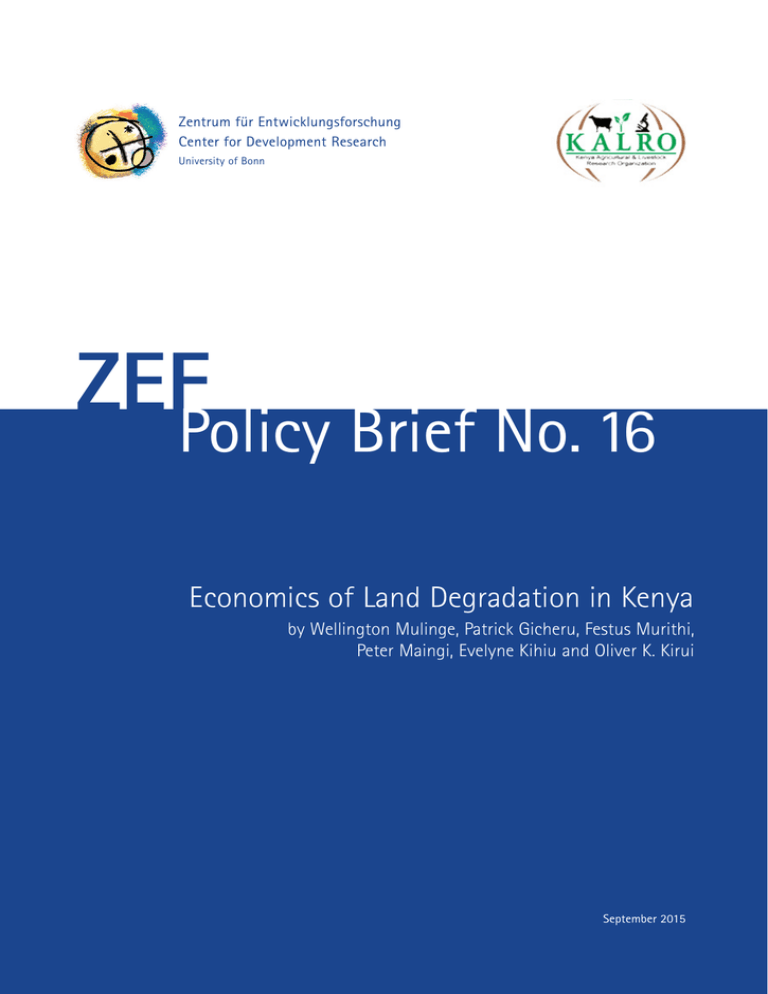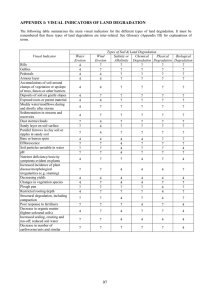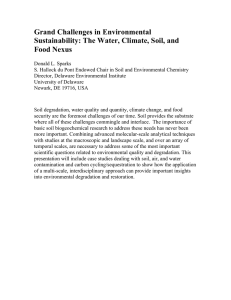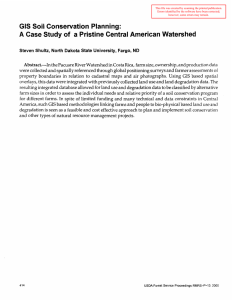ZEF Policy Brief No. 16 Economics of Land Degradation in Kenya
advertisement

Zentrum für Entwicklungsforschung Center for Development Research University of Bonn ZEF Policy Brief No. 16 Economics of Land Degradation in Kenya by Wellington Mulinge, Patrick Gicheru, Festus Murithi, Peter Maingi, Evelyne Kihiu and Oliver K. Kirui September 2015 ZEF Policy Brief No. 16 MAIN FINDINGS 1. In Kenya, 12 million people live in areas with degraded soils. The increase in crop productivity has not met the population growth, as it is constrained by soil erosion, soil nutrient depletion and loss of agrobiodiversity. 2. The costs of land degradation due to changes in land use and land cover changes were 1.3 billion USD per year between 2001 and 2009. The costs of rangeland degradation reached about 80 million USD per year. 3. 60% of surveyed households do not apply any sustainable land management technology or practice, and are thus potentially intensifying land degradation. 4. The costs of taking action to rehabilitate degraded lands is found to be lower than the costs of inaction by four times - calculated over a 30 year period. This means that each dollar invested in land rehabilitation is likely to yield four dollars of returns. 5. Kenya actually has a comprehensive Sustainable Land Management Policy. With devolution gaining momentum, capacities of Counties should be built up now in order to mitigate land degradation. Counties should understand the Sustainable Land Management policy and align it to the different ecological conditions. Reviewing and harmonizing other agricultural, environmental and forestry policies should be prioritized. Equally important is the need for reviewing and implementing Disaster Risk Management strategies to shield communities from the adverse effects of land degradation. 2 Introduction Kenya is an agricultural nation with 12 million people living in areas with degraded soils1. Population growth is exceeding the increase in agricultural output. Agricultural practices have led to soil “nutrient mining” which has substantial impacts on rural livelihoods and the economy as a whole. To date, no adequate monitoring of land degradation in Kenya exists and the growth of agricultural output continues to be constrained by soil erosion, loss of agro-biodiversity and nutrient depletion in soils2. As a matter of concern, wide-spread land exploitation is not compensated with investments into soil fertility. State and of extent Land Degradation in Kenya In general, soil fertility is lost through soil nutrient mining, wind and water erosion, deforestation and desertification. Soil and water erosion are said to have led to an annual loss of topsoil of 72 tons per hectare3. Salinization is estimated to occur on 30% of all irrigated lands4. Land degradation affects 30% of the country’s croplands3. The eastern parts of the country are most affected by degradation. The vegetation data implies that deforestation, shifts to shrublands and an increase in human settlements have led to a decrease in biomass, while water bodies have shrunk too. Drivers and Impacts of Land Degradation The major part of unsustainable land use in the country land is related to changes in land use and land cover, for example deforestation or loss of natural vegetation cover. This development is mainly caused by extraction of wood for fuel or charcoal, clearing land for ZEF Policy Brief No. 16 zation.7 -- Land degradation also leads to sedimentation of water bodies and thus reduces their surface areas.8 -- Deforestation leads to decreases in infiltration rates and deteriorating water quality. -- Changes in land use and land cover create escalating conflicts and friction over resources between the population, livestock and wildlife. This is associated with a loss of bird species, plant biodiversity and an overall decline in soil productivity.9 Drivers of Sustainable Land Management Figure 1. Potential Land Degradation in Kenya Source: The authors. agriculture and overgrazing. Drivers of deforestation include illegal logging, excision of natural parks and the outbreak of forest fires. Underlying causes of land degradation include population growth, which has led to an increasing share of marginal land being cultivated. Furthermore, the pastoralist population has increased as well, leading to a growing number of livestock. Remotelysensed and other datasets show that Kenya has experienced considerable changes in land use and land cover: -- Between 1981-2003, the productivity of croplands has declined by 40%, which is a critical development keeping in mind that the population is growing5. -- Soil erosion has led to irreversible productivity losses by 20% in large parts of the country.6 -- In addition, about 27% of irrigated lands have been lost due to salini- Land degradation is reinforced by the unsustainable management of land. Yet, about 40% of households in Kenya do apply some practices of sustainable land management. This may include cutoff drains and drainage, terraces with fodder species, contour ploughing or tree planting, use of manure, and the use of inorganic fertilizers. However, the remaining 60% of the households do not use such techniques. Agrodealers are the major provider of agriculutral extension services, followed by governmental agencies, private companies, and research institutes. Yet, high costs are often mentioned as hindrance of properly conducting sustainable land management practices. We found out that with better access to market information, agricultural dealers, and credit facilities, Sustainable Land Management measures are more likely to be carried out. Costs of action and costs of inaction of land degradation Measured by land use, the costs of land degradation have risen to about 10.6 billion USD in total between 2001-2009, 3 ZEF Policy Brief No. 16 with the biggest losses in the Rift Valley and the Coastal and Eastern provinces. Over a 30-year planning horizon, the costs of restoring and rehabilitating the lands that degraded between 2001 and 2009 would equal 18 billion USD, whereas the losses of inaction are four times higher and amount up to 75 billion USD. Similarly, the costs that land degradation causes in terms of yield loss in maize, wheat and rice could be about 270 million USD annually. This equals 1% of Kenya’s GDP. With regard to animal husbandry, results show that land degradation causes a loss in milk production of 49.5 million USD losses annually. Main conclusions About 30% of land in Kenya is affected by degradation. Considering the high population growth, it will continue to be a pressing problem. Access to extension services, research and local NGOs all facilitate the adoption of sustainable land management practices. Using the Total Economic Values framework, the economic costs of land degradation equal 1.3 billion USD per year, equaling 4.9% of the GDP (all figures in constant 2007 values for comparability). References 1 Le, Q. B., Nkonya, E., & Mirzabaev, A. (2014). Biomass Productivity-Based Mapping of Global Land Degradation Hotspots. ZEF-Discussion Papers on Development Policy, 193. 2 Government of Kenya (GoK), 2007. Kenya Vision 2030: A Globally Competitive and Prosperous Kenya. Government of Kenya (GoK), Nairobi. 3 Bai ZG & DL Dent, 2006 Global assessment of land degradation and improvement: pilot study in Kenya. Report 2006/01 ISRIC – World Soil Information, Wageningen. 4 Bai ZG & DL Dent, 2006 Global Assessment of Land Degradation and Improvement: Pilot Study in Kenya. Report 2006/01 ISRIC – World Soil Information, Wageningen. 5 Bai, Z., & Dent, D. 2008. Land Degradation and Improvement in Argentina. 1. Identification by Remote Sensing. Wageningen, The Netherlands: International Soil Reference Information CenterWorld Soil Information. 149. 6 Dregne, H. E. (1990). Erosion and soil productivity in Africa. Journal of Soil and Water Conservation, 45(4), 431-436. 7 Tiffen, M., Mortimore, M., & Gichuki, F. (1994). More people, less erosion: environmental recovery in Kenya. John Wiley & Sons Ltd. Overseas Development Institute, London 8 Kiage, L. M., Liu, K. B., Walker, N. D., Lam, N., & Huh, O. K. (2007). Recent land-cover/use change associated with land degradation in the Lake Baringo catchment, Kenya, East Africa: evidence from Landsat TM and ETM+. International Journal of Remote Sensing, 28(19), 4285-4309. 9 Maitima J. M. Mugatha S.M., Reid R.S., Gachimbi L. N., Majule A., Lyaruu H., Pomery D., Mathai S. and S. Mugisha, 2009. The linkages between land use change, land degradation and biodiversity across East Africa: African Journal of Environmental Science and Technology Vol. 3 (10), pp. 310-325, October, 2009. Recommendations. We need: -more research and extension services to increase crop yields and meet a growing demand for food, energy, fiber and timber in Kenya; -Protection of biodiversity and ecosystems to abate pressure to turn remaining natural lands into cropland. -more public investment to promote sustainable land management practices and slow down degradation. IMPRINT Publisher: Zentrum für Entwicklungsforschung (ZEF) Center for Development Research Walter-Flex-Strasse 3, 53113 Bonn Germany phone: +49-228-73-1846 e-mail: presse. zef@uni-bonn.de www.zef.de Contact: Oliver Kirui, ZEF, okirui@uni-bonn.de Editors: Rebecka Ridder, Wellington Mulinge and Alma van der Veen 4 Layout: Katharina Zinn


![Pre-workshop questionnaire for CEDRA Workshop [ ], [ ]](http://s2.studylib.net/store/data/010861335_1-6acdefcd9c672b666e2e207b48b7be0a-300x300.png)



